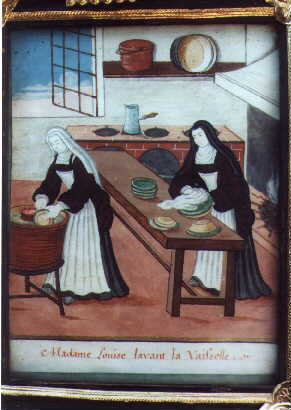The upshot is that she continued to struggle and fight to drive the wicked out of the Church. As you know, when the French Revolution broke out there were four atheist bishops who did not even blush when calling themselves atheists. One of them is the famous Talleyrand. This gives you an idea of what everything else was like. So Madam Louise would make a tremendous effort to bring religion back in there and thus avoid the storm she saw approaching. But France was sliding down the criminal ramp and did not stop. And the first royal blood that the Revolution shed was not that of Louis XVI.
While one can naturally suspect that Dauphin Louis, the son of Louis XV and father of Louis XVI was murdered, there is every reason to suspect that so was Madam Louise (there are books that abundantly prove that she was poisoned, such as the biography published by the Carmelite Monastery of Concenedo, Italy, titled Dalla Reggia al Carmelo – Luisa di Francia, by the Minep-Docete Publishing House of the Italian Carmelite Fathers, 2002, 183 pages).
 The wicked claimed that kings were good for nothing even as they removed, from the steps of the throne, the men of virtue and holiness that flourished there. Such is the hypocrisy of the Revolution. They were removed on the suspicion they might become obstacles.
The wicked claimed that kings were good for nothing even as they removed, from the steps of the throne, the men of virtue and holiness that flourished there. Such is the hypocrisy of the Revolution. They were removed on the suspicion they might become obstacles.
And here you have the glory of Madam Louise: She was so active from the Carmel that she was feared by the revolutionaries! A simple Carmelite nun, stripped of all her honors and prerogatives of power, was so feared by the Revolution that they felt she had to be poisoned so they could advance.
Therefore, her life was offered as a holocaust to France. That was the glorious end of the existence of a princess worthy of consideration in all respects and duly acclaimed as granddaughter of St. Louis IX.
What could have been worth the existence of Venerable Louise de France? One might say: “The Revolution broke out, the throne fell, secularism entered France, egalitarianism invaded France and began its slow corrosion which today is paving the way for communism. Her life was lost and her efforts wasted, to no avail…” How incorrect such an assessment would be!
In fact, all historians are convinced that the Catholic reaction to the onslaughts of the French Revolution was surprising. All of them recognize that the barrier which the Vendeans [counterrevolutionaries in the French Vendee region] opposed was admirable; that an unexpected number of nuns, priests and even bishops refused to take the oath required under the Civil Constitution of the Clergy. When we read attentively certain anti-Catholic historians we observe that they give to understand the following: The reaction to the religious persecution was so much stronger than the reaction against the persecution of the monarchy that it must be recognized that it was a mistake for the French Revolution to have simultaneously attacked both the monarchy and religion. And, they say, it would have been wiser not to persecute religion but to establish the republic — the turn of religion would come later. In other words, divide and rule.

The refectory of the Carmel of Lisieux, at the time of St. Therese of the Child Jesus. Below, living room in that same convent.
What is the reason for this religious renaissance? It is evident that the immolation of Sister Louise of France was not alien to this. If the death of the righteous is precious before God, her death must have been of great weight. And her life had already been of such great weight before men!
There was the counter-revolution of the Vendeans. And thanks to it, there was the French ultramontane* movement in the nineteenth century, which Prof. Fernando Furquim has chronicled so well in the pages of Catolicismo. The spirit of the ultramontane movement of France spread to Brazil. In fact, it spread as an excellent perfume throughout the Church. And I encountered it when still in my childhood. I was enraptured, enthusiastic, and set out to collect in my soul, intellect, will and sensibility all the traces of ultramontanism, still palpitating with life, that I found in the environment in which I was born.
So, in the final analysis, there is a whole genealogy of Catholics who fought at court against the influence of the French Revolution, led by Madam Louise and Madam Clotilde, from them to the Vendeans, from these to the ultramontanes, and from the ultramontanes to the Catolicismo movement. God alone knows if a little or a lot of the last tears and groans of Madam Louise stand behind the enormous graces we have received for the ultramontane movement in Brazil. Which is why it is more than just and fair that we remember her tonight with emotion and respect. And that we ask her, as well as Madam Clotilde and all those who prayed, suffered, fought and died for the defeat of the French Revolution before it broke out, while it lasted, and after it began to spread throughout the world, that they obtain for us the grace of an extraordinary fervor, of a unique fighting spirit, of a supreme understanding of the spirit of the Counter-Revolution.
(Saint of the Day, Thurs., Dec. 22, 1966 – Nobility.org translation)
* Ultramontane, from the Latin ultramontanus, meaning “beyond the mountains,” specifically, beyond the Alps to those who are in France or Germany, refers to the Catholic political doctrine that finds its main reference in Rome. This movement arose precisely from the French side of the border in the first half of the nineteenth century. It reinforces and defends the pope’s power and prerogatives in matters of discipline and faith. Joseph de Maistre and Louis Veuillot stood out as leaders of this thought.











